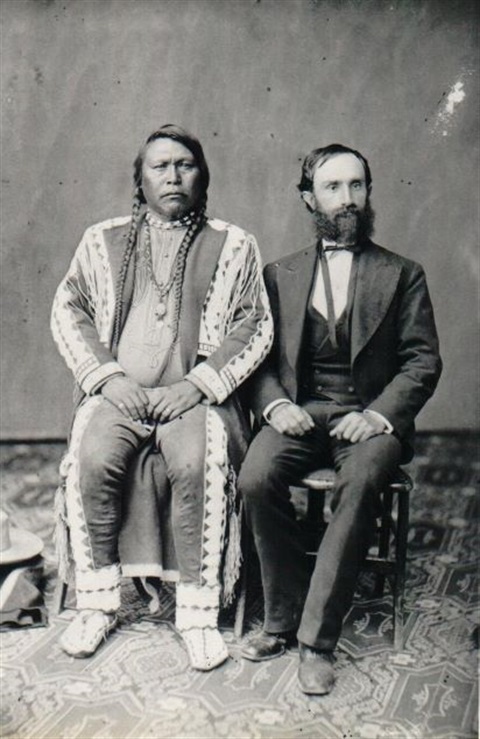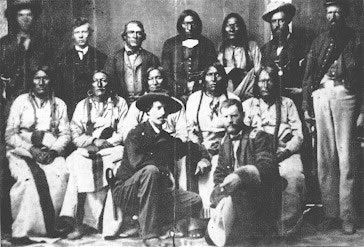Native Americans in the History of Littleton

Thousands of years before the settlement known as Littleton existed, other humans lived and hunted here. One confirmation of this was the discovery in 1960 of bones of extinct mammoth, camel, horse, and bison, along with primitive tools and a hearth, at Lamb Springs about seven miles southwest of Littleton. These transient prehistoric Indians, however, left little trace and not much is known about them.

Arapaho and Cheyenne meet in Denver at the Camp Weld peace conference, September 1864. Photograph courtesy of the Colorado Historical Society
By 1500, and probably earlier, the Apache controlled the Colorado plains, where they hunted buffalo on foot and planted crops along the river bottoms. In the early 1700s they were forced south by invading Comanche, who were followed in turn by the Kiowa. The Comanche and Kiowa first fought, then made peace, and gradually moved south together through Colorado to the plains below the Arkansas River. Behind them came the Arapaho.
The use of horses, which were used by the Ute as early as the 1600's, gave the Indians greater mobility, allowing them to range over much more land and to extend their dominions. Between 1810 and 1820 the Arapaho ranged between the North Platte and Arkansas rivers and westward to the foothills of the Rocky Mountains. About 1815, and probably at other times, a rendezvous was held between a group of French trappers and members of the Arapaho, Cheyenne, Kiowa, and other tribes, at a spot along Bear Creek just north of present Littleton.
The Arapaho and Cheyenne had formed a strong alliance before 1800, and those two tribes occupied most of eastern Colorado when groups of settlers began to arrive. Hunting buffalo was an important part of Indian society at this time. The Arapaho were certainly familiar with the South Platte area; Arapahoe County was aptly named for this tribe, although the spelling differs.
They fought for decades with their enemies, the Ute. Although the Ute occupied only the mountainous area of Colorado, they hunted buffalo "as far out onto the plains as the shadows of the Rockies stretch at sunset." Battles over hunting grounds were common.
Claiming land in the Platte River Valley was occasionally risky for settlers in the 1860s since the Arapaho and Cheyenne tribes were still present in the area. However, the rush for gold and land was on in Colorado, and there was little the Indians could do to prevent the likes of Richard Little, Joseph Bowles, John Lilley, Lewis Ames, Peter Magnes, and others from staking claims. When the Civil War depleted western military posts of their troops, life for pioneer farmers, as well as for travelers, became even more hazardous as bands of Arapaho and Cheyenne, and even the friendlier Ute, raided farms and ranches. Some families fled to Denver, leaving farms abandoned for long periods of time.
Conflicts culminated in November 1864 when a regiment of Colorado volunteers staged the infamous Sand Creek Massacre of Arapaho and Cheyenne families camped on their own reserved lands. The effect on the Cheyenne and Arapaho was their eventual removal to reservations in Oklahoma and Wyoming. The path to removal for the Ute was similar, but more gradual, and was given its final stimulus when Indian Agent Meeker was killed by the Ute at the White River Reservation in 1879. They were eventually confined to reservations in western Colorado and Utah.
A number of Indians remained and many lived in the metro-Denver area. In the late 1960s, as part of the "War on Poverty," the Bureau of Indian Affairs set up a liaison office in Denver. A branch in Littleton was added shortly afterwards. On March 16, 1970, Indians again entered Littleton history when they staged a sit-in at the B.I.A. offices on Littleton Boulevard. A pivotal moment in the Indian Civil Rights Movement, the protest began when 12 Indian employees filed a formal complaint to the B.I.A. The complained stated the Plant Management Engineering Center, or PMEC, located at 1100 West Littleton Boulevard, engaged in discriminatory practices in hiring, promotions, and training of Native employees, as well as misusing government funds intended for Indians. The group was called "the Littleton Twelve" and soon, more local and national Indian organizations endorsed the protest. By March 16th, 1970, the activists and their supporters began picketing the office. After three days of protesting and a meager response from the bureau, several employees locked themselves in the building, using snow chains from a car. Nine of the activists were arrested after several days, being charged with trespassing and interference. The group was taken to the nearby jail at the Arapahoe County Court, where they were later acquitted of all charges and declared innocent on June 23, 1973. Following the sit-in in Littleton were more protests in Denver and across the country. By using non-violent methods of direct action, the resulting protests led to a lawsuit (Freeman vs Morton), which went the United States Supreme Court. The Court eventually ruled in favor of Indian Hiring Preference.
For further reading:
- Americans Indians In Colorado. J. Donald Hughes.
- The Arapahos, Our People. Virginia Cole Trenholm.
- The Cheyennes: Indians Of the Great Plains. E. Adamson Hoebel.
- A Colorado History. Carl Ubbelohde, Maxine Benson, and Duane S. Smith.
- The Fighting Parson: The Biography Of Colonel John M. Chivington. Reginald S. Craig.
- Littleton, Colorado. Settlement To Centennial. Robert J. McQuarie.
- The Sand Creek Massacre. Stan Hoig.
- The Utes, A Forgotten People. Wilson Rockwell.
Bibliography
Falcon, Jennifer (Fort Peck Assiniboine Sioux). Shut It Down! BIA Abuses and the Littleton 12: Indian Country Today, March 9, 2016.
Hughes, J. Donald and Department of History, University of Denver. American Indians In Colorado. Boulder, Colo.: Pruett, 1977.
Littleton Historical Museum. Exhibits--Records: "Objects of Life: Arapaho/Cheyenne," 1979.
McQuarie, Robert J. Littleton, Colorado. Settlement To Centennial. Littleton, Colo.: Littleton Historical Museum and Friends of the Library and Museum, 1990.
Ubbelohde, Carl, Maxine Benson, and Duane A. Smith. A Colorado History. Boulder, Colo.: Pruett, 1965, (7th edition, 1995.)
Photographs courtesy of the Littleton Museum, unless otherwise noted; to order copies, contact the Museum at 303-795-3950.
Compiled by Doris Farmer Hulse
Updated April 2021 by Phyllis Larison